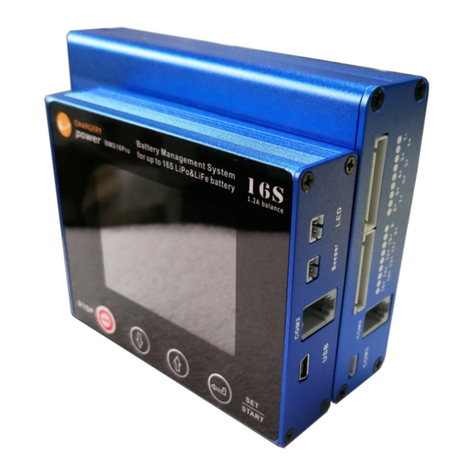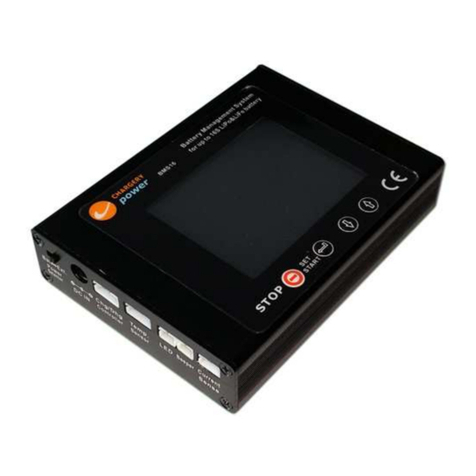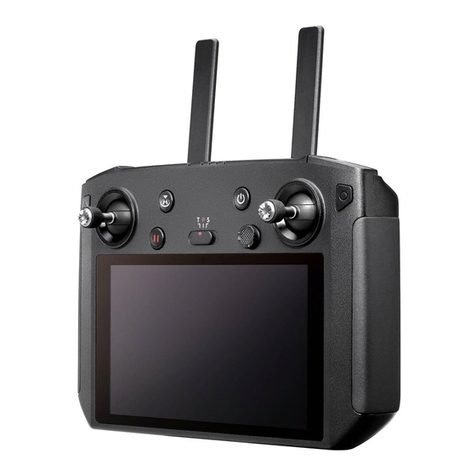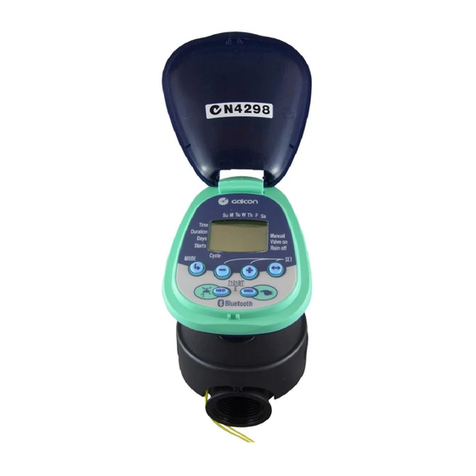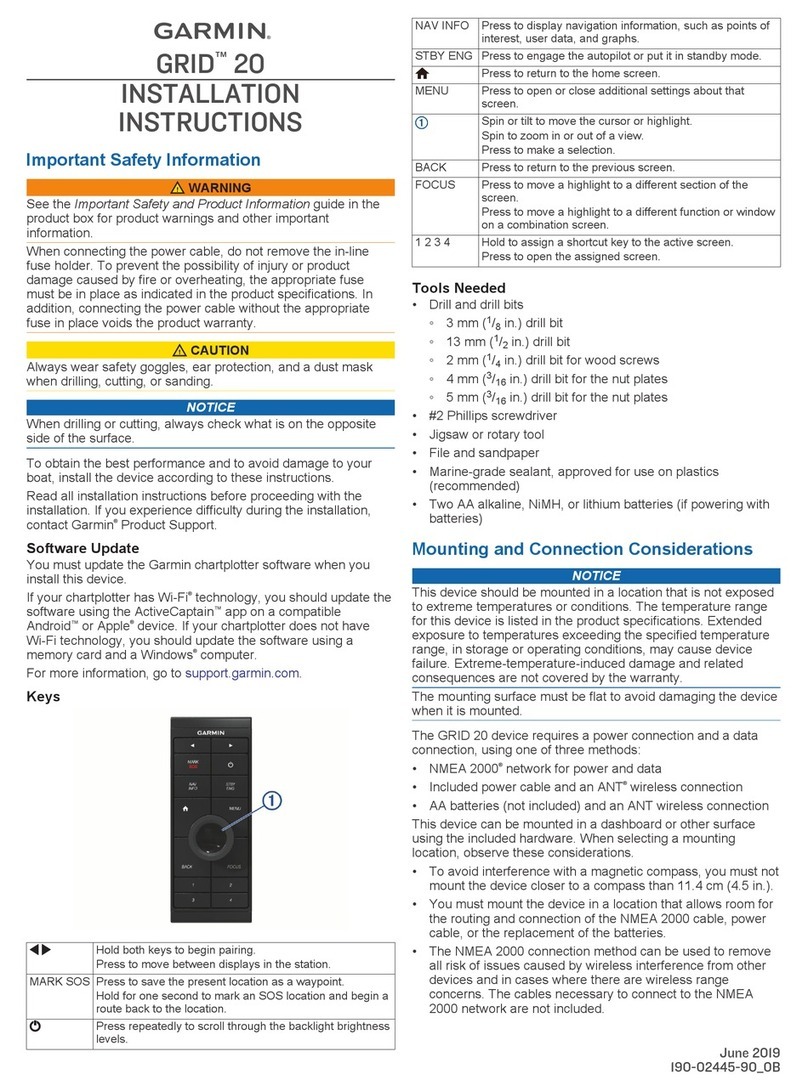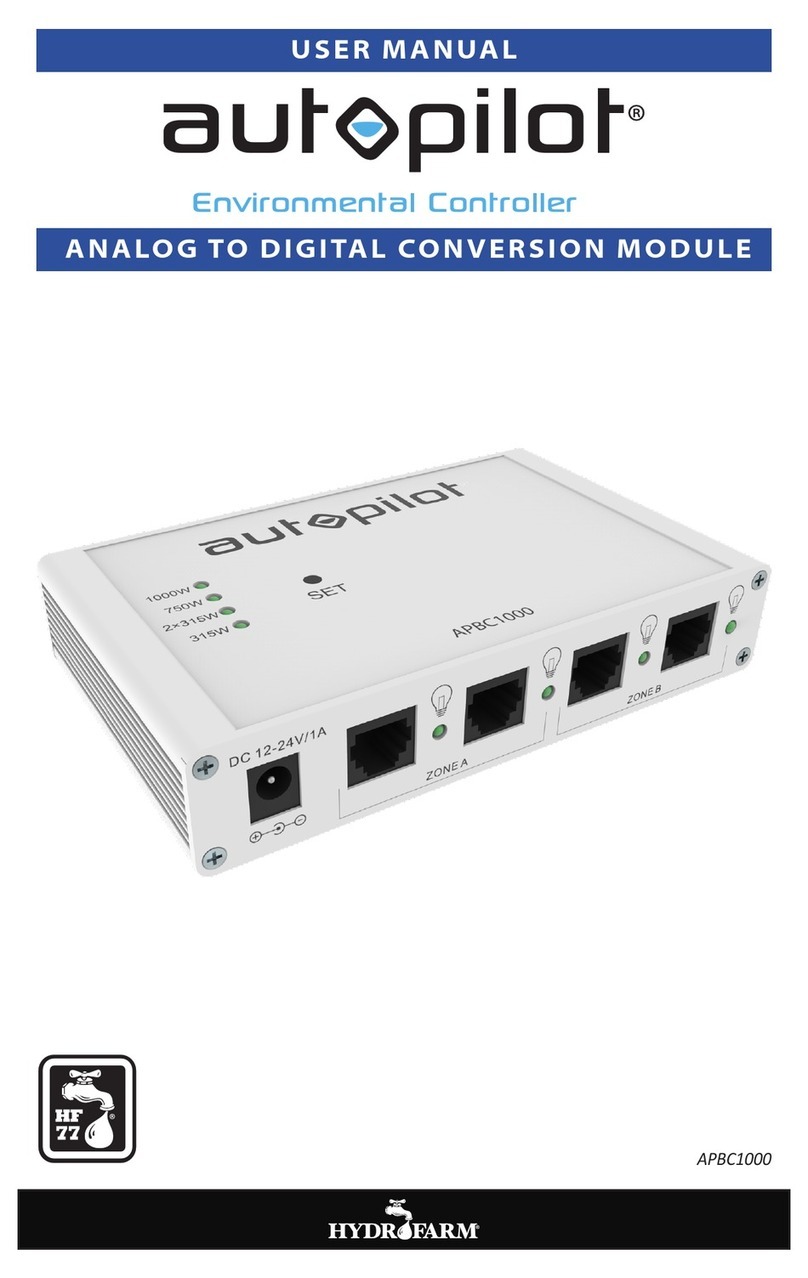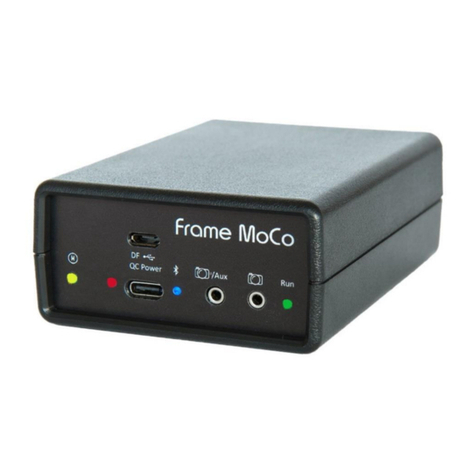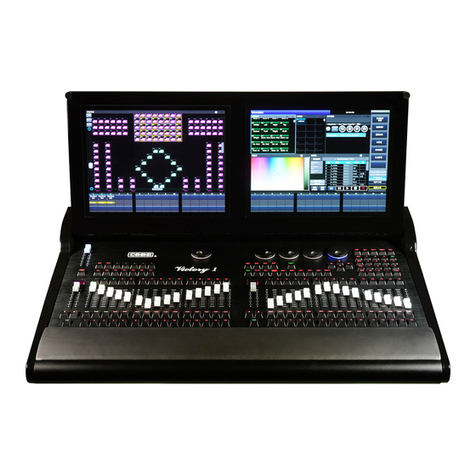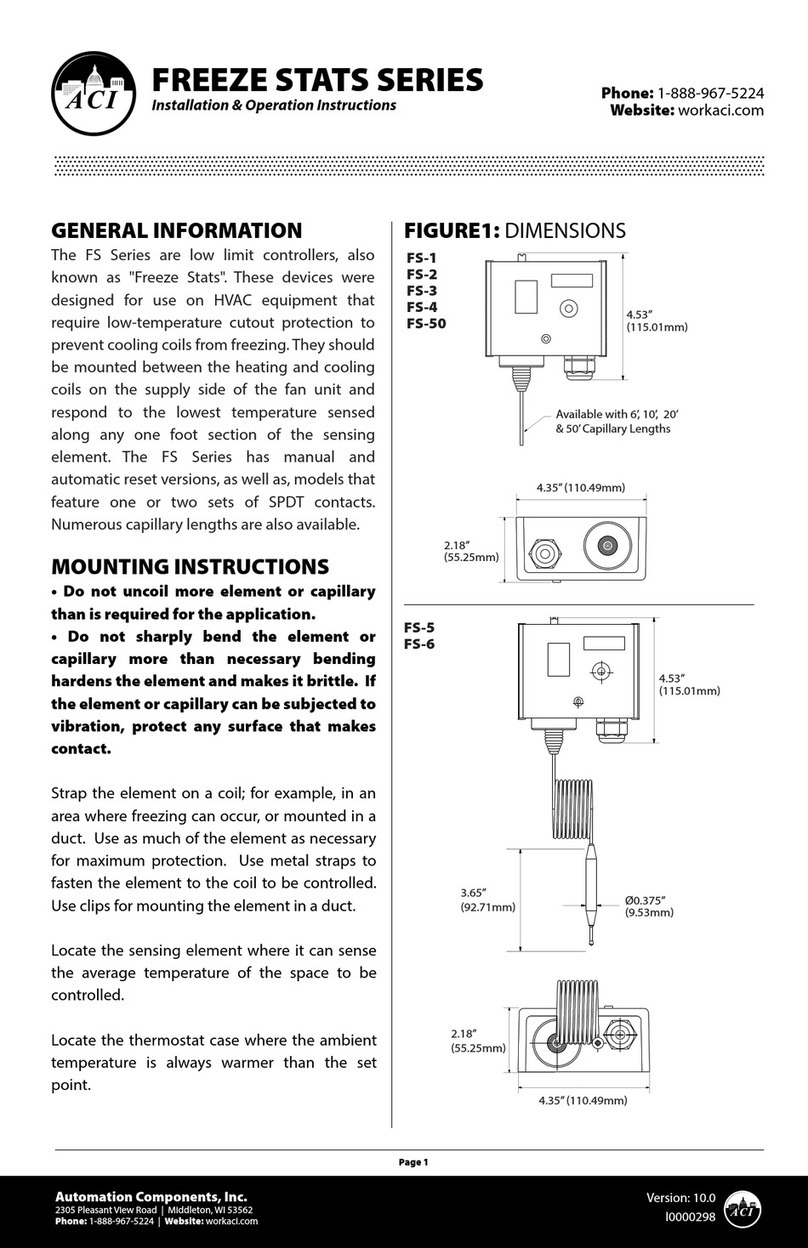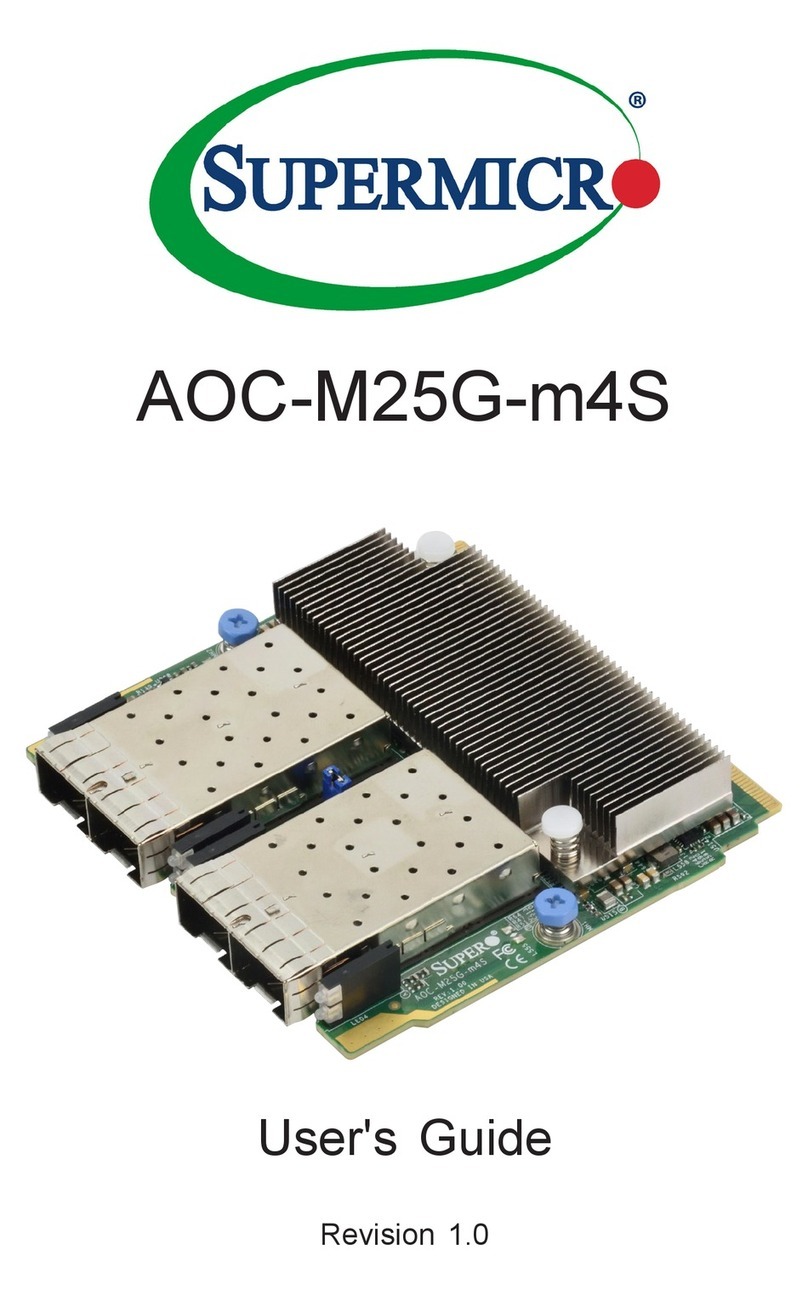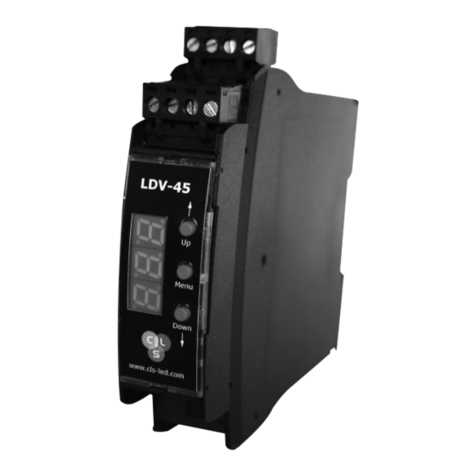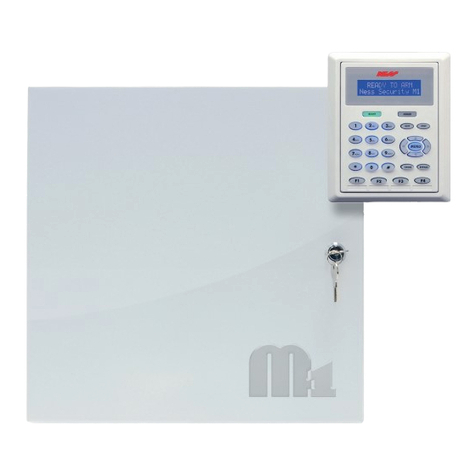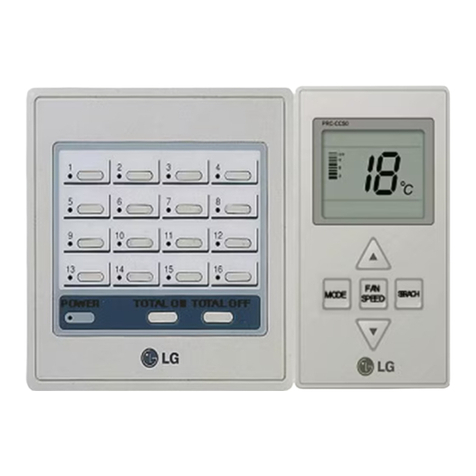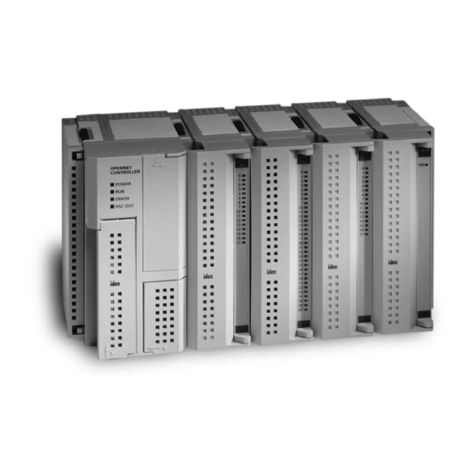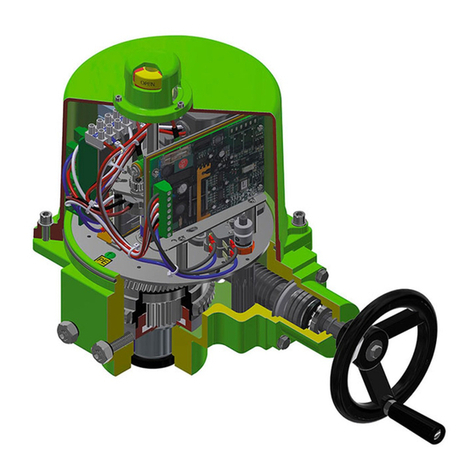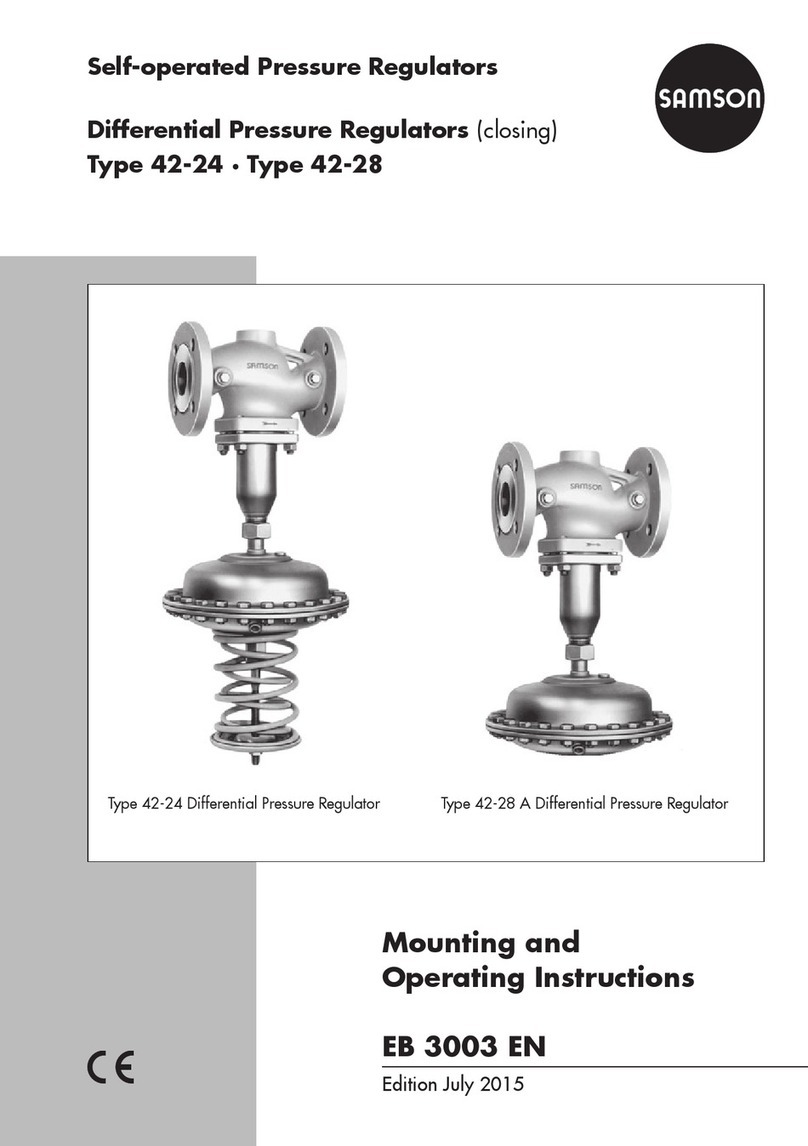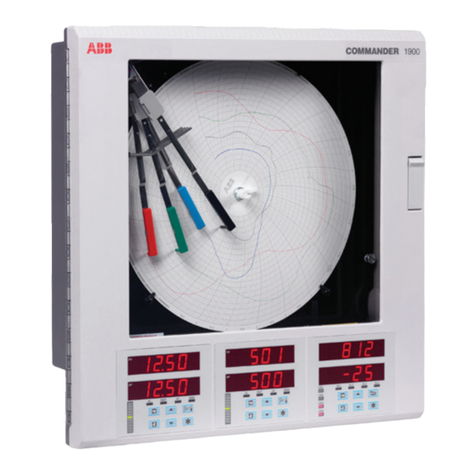Chargery BMS8P User manual

Revised : 28/2/2020
BMS8P
for 2S-8S LiPo/Li-ion, LiFe & LiTO
Low power consumption
High accuracy
2.8” TFT LCD display
Programmable
Chargery BMS8P
attery Management System for 2S-8S LiPo/Li-ion, LiFe & LiTO
Low power consumption, High accuracy, 2.8” TFT LCD display, Programmable
Owners Manual
V .3
Main Unit Software Version .05
LCD Unit Software Version .03

LiPo & LiFe, LiTo attery Management System MS8P V4.3
www.chargery.com
page 2 total 62
Thank you for choosing the Chargery MS8P as your attery Management System. This versatile
MS is designed to be suitable for Electric Vehicles and mobile / fixed Energy Storage Systems
providing extensive flexibility for your specific application.
Please read the ENTIRE instruction manual to become familiar with the features and functions and
capabilities of the device before operating. Please see Video References for additional installation
& operational tips.
Overview:
The Chargery MS8P is designed especially for LiPo, LiFe and LiTo battery packs applied to Energy
Storage Systems and Electrical Vehicles including E-Motorcycle, E-Scooter and so on. The unit can
measure or detect the battery voltage, cell voltage, charge & discharge current, battery
temperature, and battery SOC (State of Charge), with the information displayed on the TFT color
LCD screen. It has an Internal balancing function to balance cells to maintain optimal operations
of the battery pack being managed.
Feel free to send an email to jasonwang[email protected] or call at 86 755 2643 6165 should you have
any questions and suggestions.
Jason Wang

LiPo & LiFe, LiTo attery Management System MS8P V4.3
www.chargery.com
page 3 total 62
Table of Contents
Safety Notes .................................................................................................................................................................. 5
Warning ................................................................................................................................................................... 5
Copyright ................................................................................................................................................................ 5
Specifications ................................................................................................................................................................ 6
Protection functions .................................................................................................................................................... 6
Over current protection ............................................................................................................................................. 6
Version History ............................................................................................................................................................. 7
Update / Change log .................................................................................................................................................. 8
Order information ........................................................................................................................................................ 9
Standard accessories (included in MS unit) .......................................................................................... 9
Current Shunt ..................................................................................................................................................... 10
DC Contactor ....................................................................................................................................................... 11
DCC main Specification ........................................................................................................................... 12
ISO board ..................................................................................................................................................... 13
Chargery DC Contactor (DCC) configuration in Common and Separate Port..................................... 14
Alternator Saver ......................................................................................................................................................... 16
Operational Description ........................................................................................................................................... 19
Special Features ......................................................................................................................................................... 20
Interface ........................................................................................................................................................................ 21
Hardware Setup ......................................................................................................................................................... 23
Absolute maximum or Minimum ratings (Always refer to Manufacturer specifications) ........ 23
Software Configuration ............................................................................................................................................ 24
Parameters Setting----Configuration Values ................................................................................................... 25
Operating guideline ................................................................................................................................................... 28
SOC Calibration .......................................................................................................................................................... 31
alancer ........................................................................................................................................................................ 33
alancing Indicator ........................................................................................................................................... 34
Cell internal resistance (Impedance) test ........................................................................................................ 35
Charge and discharge relay lectotype for MS8P ......................................................................................... 37
Current Calibration (Shunt) ................................................................................................................................... 38
Firmware Upgrades via US Port......................................................................................................................... 40
Update MS main unit ..................................................................................................................................... 41
Continue to update LCD unit ......................................................................................................................... 41
Typical Cell Connections .......................................................................................................................................... 43
2S-4S configuration and 8S configuration ............................................................................................... 43
4s & 4s with single MS8P configuration example. .............................................................................. 44
6P4S 24 cells with single MS8P configuration example. .................................................................. 45
Nissan Leaf battery 6P8S with MS8P configuration example ....................................................... 45
Separate Port Configuration example—with Mechanical relay or DCC. ................................................ 46
Common Port Configuration example—with two Mechanical relay or one CHARGERY DCC. ....... 47
4p4s Cell configuration with MS8P-600 example ....................................................................................... 48
Related parts ............................................................................................................................................................... 49
Total solution on E-Vehicle application—1500W 60A 8S battery charger ............................................ 50
Supplemental: Solid State Relay supplemental information .................................................................... 51
Supplemental: Single Relay with 2 channel Opti-Coupler ......................................................................... 52

LiPo & LiFe, LiTo attery Management System MS8P V4.3
www.chargery.com
page 4 total 62
Supplemental:Equipment Voltage Calibration .............................................................................................. 53
Supplemental: Reference Documents & Video links .................................................................................... 55
Supplemental: MS power consumption .......................................................................................................... 56
Frequent questions ................................................................................................................................................... 57
Improve cell voltage accuracy .............................................................................................................................. 59
Improve current reading fluctuation from Steve ........................................................................................... 60
Over Current protection resume operation ..................................................................................................... 61
Warranty and Service ............................................................................................................................................... 62

LiPo & LiFe, LiTo attery Management System MS8P V4.3
www.chargery.com
page 5 total 62
Safety Notes
Please read the entire manual completely before using, to ensure safe and efficient use.
1.
Ensure the MS program and settings match your battery pack, otherwise the battery may be damaged
and a dangerous situation may arise, especially for Lithium based batteries, which may catch fire.
2.
Use the attery Cell Manufacturers specifications and information when configuring your MS.
3. For Energy Storage System and Electric Vehicle applications, there are many different requirements,
please adjust those key parameters carefully for your application, or contact us for more details.
4. Do not allow water, moisture, metal wires or other conductive materials to come in contact the device.
5. Never charge or discharge any battery having evidence of leaking, expansion/swelling, damaged outer
cover or case, color-change or distortion.
6. Do not try to charge “non-rechargeable” dry cells.
7. Do not mix batteries of different types, different capacities or from different manufacturers, all cells used
should be of matching specifications.
8. Do not exceed the battery manufacturer’s suggested maximum charge and discharge rates.
9. Carefully follow the battery pack manufacturer’s recommendations and safety advice.
Warning
1. The Current shunt must not make contact with any metal including the MS case
2. The MS case should not be in direct contact to any metal
3. External power supply ground don’t connect to battery negative (cell 1 negative) directly
4. Current shunt must connected to the attery Pack Negative !
5. Prevent MS from vibrations and shaking
6.
Ensure the MS case does not make contact with battery wiring in any way.
Copyright
Copyright@Chargery Power Co., Ltd. All rights reserved.
Without prior written consent by Shenzhen Chargery Power Co., Ltd, any units or individual extract and copy
parts or entire contents of this manual, and transmission in any form is illegal and strictly prohibited.
The product described in this manual, may include copyright software ownership belongs to Shenzhen
Chargery Power Co., Ltd and its licensee, except getting the permission from relevant rights holders,
otherwise any copy, distribute, modify, excerpt, decompile, disassemble, decrypt, reverse engineering, lease,
transfer, sub-license, as well as other acts of infringement of software copyright is strictly prohibited, but
apart from the restrictions prohibited by applicable law.

LiPo & LiFe, LiTo attery Management System MS8P V4.3
www.chargery.com
page 6 total 62
Specifications
1. attery range: 2S-8S LiPo & LiFe, LTO battery pack
2. Accurate scope of the cell voltage: -5mV/+5mV
3. Cell Voltage display range: 0.10~4.99V
4. The voltage of external power:15-60V, 3A.
5. alance current:1.2A per cell continuously
6. Temperature display range:-20℃~150℃,
7. SOC indicator:
RED area @ 0~15% of SOC
YELLOW area @ 16~35% of SOC
GREEN area @ 36~100% of SOC
8. uilt-in cooling fan, start automatically upon internal temperature
9. Main module Size: 122×88×38 (L×W×T, mm) or 4.8×3.5×1.5 (L×W×T, inch)
10. Main module weight: 270g excluding accessories
11. Display module size:96×80×24 (L×W×T, mm) or 3.8×3.2×0.95 (L×W×T, inch)
12. Display module weight:130g
13. Warning LED: 11000mCd, @ 2.0V, 20mA
14. Warning beeper: 85d @ 12V, 25mA
15. Package: AL alloy case
Protection functions
1. Cell count error protection
2. Over charge protection
3. Under voltage protection
4. Over current protection when charge or discharge
5. High temperature protection
6. Low temperature protection (on LCD unit V3.03 and higher version)
7. Over differential cell voltage protection in discharge
8. Over differential battery temperature protection
9. Under SOC protection
Over current protection
When charge or discharge current reach over charge current setting or over discharge current setting, MS
will cut off charge or discharge, to resume charge or discharge, please press SET/START button shortly. ut
the over current reason should be removed first.

LiPo & LiFe, LiTo attery Management System MS8P V4.3
www.chargery.com
page 7 total 62
Version History
Software Version of LCD
unit
Description
V4.03
Released first time
Software Version of
main unit
Description
V4.05
first released
Hardware Description
lack mental case with cooling fan

LiPo & LiFe, LiTo attery Management System MS8P V4.3
www.chargery.com
page 8 total 62
Update / Change log
MS8P v4.05 has the following changes that is compared with MS8T,
o
Add intelligent cooling fan, start automatically and speed is controlled by internal
temperature, so MS8T cannot update to MS8P only by update software. And
the MS can balance cell voltage continuously, to save balance time by speed up
balancing even at 1.2A per cell.
o
Minimum current 0.5A measurement capacity on 300A / 600A shunt
o
Minimum current 0.3A measurement on 100A shunt
o
Improve cell voltage detection accuracy
o
Improve AH reading accuracy
o
Add Discharge End voltage of cell, and charge, discharge status send out -----
Protocol v1.26

LiPo & LiFe, LiTo attery Management System MS8P V4.3
www.chargery.com
page 9 total 62
Order information
Model
Description
Accessories
MS8P-100
100A charge and discharge
100A shunt, and standard accessories
MS8P-300
300A charge and discharge
300A shunt, and standard accessories
MS8P-600
600A charge and discharge
600A shunt, and standard accessories
Standard accessories (included in MS unit)
US data cable: Update main
unit and LCD unit
Cell alance wire: connect cell
to MS balance port, 600mm
DCC/Relay controller wire:
cut off charge /discharge ,
600mm.
Temperature sensor: 600mm,
monitor battery temperature.
Warning LED, 300mm Warning eeper, 300mm
Current sensor wire, 600mm,
monitor charge /discharge
current
Communication wire (4.5
meters), connect main unit to
LCD unit
COM3 Data line: connect to
external device, send out all
data

LiPo & LiFe, LiTo attery Management System MS8P V4.3
www.chargery.com
page 10 total 62
Current Shunt
A single shunt is used for the MS8P, it is delivered with MS and other standard accessories. The MS8P
detects the charge and discharge currents using the same shunt. All supplied shunts are voltage and current
calibrated prior to delivery. If you exchange the shunt, 75mV or less is recommended, and need calibrate
again.

LiPo & LiFe, LiTo attery Management System MS8P V4.3
www.chargery.com
page 11 total 62
DC Contactor
CHARGERY designed the special DC contactor or named as SSR to fit with all MS, DCC is used for cut off
charge or discharge when any cell voltage reach settings to prevent any cell from damage and possibly fire.
The DCC must be installed on battery positive with ISO board, the board will be ship with DCC, on next
generation DCC, the board will be built-in DCC.
efore using DCC, please note the charge and discharge is on common port or separate port. The DCC has
different hardware on both type port.
Notes
If without DCC, MS will only warn by eeper sound and LED flash.
One DCC can be used in a Common port such as a Solar system, instead of two SSR's or relays.
The Relay Delay Time board (op is to avoid a surge current when start to charge or discharge. If using a
CHARGERY DCC, the delay board is not required, because it has a uilt-in the surge suppressing circuit.
For other SSR or mechanical relay, please consider the surge current seriously and make a suitable plan.
For more detailes please download and read DCC manual V1.2 carefully
http://chargery.com/doc/Chargery_DC_contactor_manual_V1.2.pdf

LiPo & LiFe, LiTo attery Management System MS8P V4.3
www.chargery.com
page 12 total 62
DCC main Specification
DC Contactor (DCC) model
DCC-100HB DCC-200HB DCC-300HB DCC-600HB
Driving voltage
12V
Holding current (Avg.) at 12V
9mA 11mA 11mA 11mA
Rated Operating Voltage
100V
Continuous (Carry) Current, Typical
100A 200A 300A 600A
Maximum current, at 85°C for 2 seconds
200A 300A 500A 1000A
Maximum Contact voltage drop at 100A
200mV 136mV 80mV 40mV
Fan start Temperature
>42°C >42°C >42°C
Over temperature protection---- Turn off
temperature
>90°C >90°C >90°C
Turn on temperature automatically
<80°C <80°C <80°C
Current mode
bi-directional
Size(L*W*H, mm)
105*55*40 105*64*55 105*90*55 142*105*55
Weight(Kg)
0.3 0.45 0.7 1.2
Operating Ambient Temperature
-40 to +85 °C
Cold pressing copper tube terminal
10-6 25-6 50-8
Screws
M6*16 M8*20
Wire Area(mm
2
) requirements
18 30 50 70
Ambient Temperature
-10--45℃
Ambient Humidity
5%--95%
Storage Temp.
-20℃--70℃
Storage Humidity
30%--90%
Status Indicator
Red LED is ON at DCC closed, and OFF at DCC open.
Power Indicator
Red LED is ON, The unit is ON. Red LED is OFF, means MS cut off charge
and/or discharge, or if High/Low temperature protection has been
triggered, or Temperature sensor is disconnected from the MS.
Driven Port
Status Indicator
Po er S itch
Po er Indicator

LiPo & LiFe, LiTo attery Management System MS8P V4.3
www.chargery.com
page 13 total 62
ISO board
The board is designed special for DCC, as we know the DCC install on the positive side is
better and safer than install on negative, so we designed the board.
The board should connect between MS relay controller port and DCC. There is two LEDs, One
indicate charge control signal, another indicate discharge control signal. As below.
When
over charge triggered, MS cut off charging, the charge LED on ISO board and Status
LED on DCC will be off.
When
over discharge triggered, MS cut off discharging, the discharge LED on ISO board and
Status LED on DCC will be off.
Charge control signal
Discharge control signal
Charge control signal
Discharge control signal

LiPo & LiFe, LiTo attery Management System MS8P V4.3
www.chargery.com
page 14 total 62
Chargery DC Contactor (DCC) configuration in Common and Separate Port
BMS Current sensor
shunt
Battery Pack
fuse
Charger/
Inverter
Chargery DCC
ISO board
Battery (-)
Battery
BMS relay controll
er
DCC on Common port connection
BMS Current sensor
Battery Pack
ISO board
Battery (-)
Battery (+)
BMS
Relay controller
DCC on Separate port connection
Charger
Inverter/load
Chargery DCC
Chargery DCC
fuse

LiPo & LiFe, LiTo attery Management System MS8P V4.3
www.chargery.com
page 15 total 62
BMS Current sensor
Battery Pack
ISO board
Battery (-)
Battery (+)
BMS Relay controller
DCC on Separate and common port connection
Inverter as load and charger, Solar panel charge
battery too
Solar Charger
Inverter/charger
Chargery DCC
(Common port)
Chargery DCC
(Separate Port)
fuse
Charge control signal
Dis
c
harge
control signal
ISO board
BMS

LiPo & LiFe, LiTo attery Management System MS8P V4.3
www.chargery.com
page 16 total 62
Alternator Saver
The alternator on a car or boat needs 12V or 24V in order to magnetise the field on the
alternator. Without that it will produce no current at all. Regulating this current is used in the
internal regulation on an alternator to regulate the output of the alternator. The same
capability is used on external regulators as almar or Grassder Smart Charge one or Sterling
ProReg-D. When the batteries have reached floating level they will send less current through
the magnetising field of the alternator in order to limit the output.
When MS cut off charging by “open” DCC or relay directly, this will burn the diodes in the
alternator.
The Alternator saver can switch off the magnetising current to the field of the alternator just 3
seconds before the contactor switch off, so protect the diodes of the alternator.
A small isolated relay cutting the power to the magnetising field could do the trick, the relay
will be “open” first by the Saver board before DCC cut off charging.
The feature could be useful for many boaters and others who charges with alternators.

LiPo & LiFe, LiTo attery Management System MS8P V4.3
www.chargery.com
page 17 total 62
Common port DCC connection diagram with 2 8S batteries.

LiPo & LiFe, LiTo attery Management System MS8P V4.3
www.chargery.com
page 18 total 62
Separate port DCC connection diagram with 2 8S batteries.

LiPo & LiFe, LiTo attery Management System MS8P V4.3
www.chargery.com
page 19 total 62
Operational Description
The MS8P includes a Main Unit and a Display Module. Once the hardware installation is completed and ready,
power on the MS8P to finish setting up all of the parameters using the Display Module. The MS8P will use
the saved settings even if the Display Module is disconnected from the Main Unit. Removing the Display
Module disables the data display, beeper and warning LED but the MS will still function properly and can cut
off charge / discharge when any set condition requires it. You can connect an external device such as a
computer to the COM3 port on the Main Unit to receive all RS232 data. To modify the parameters in setup,
please reconnect the Display Module, no data can be written to the MS from an external application at this
time.
The MS8P can be used with any lithium battery charger, when any cell is over charged, the MS8P will open
the charge relay to cut off charge, if used with a CHARGERY charger, the charge control is handled by
connecting the CHARGERY charger to the MS8P on COM1, when any cell reach OVP, the charge current will
decrease automatically to prevent any cell damage. This feature can save charge relay cost and shorten
charge time.
More information on the RS232 Data Interface can be found in Supplemental: Reference Documents & Video
links
Special NOTE: The RS232 output is wired in a Cross Over fashion. Refer to RS232 Document for pin out. This
can be wired to any type of adapter being used, such as RS232, RJ-11, RJ-45. Pin outs must be observed
accordingly.

LiPo & LiFe, LiTo attery Management System MS8P V4.3
www.chargery.com
page 20 total 62
Special Features
1. The MS8P uses advanced ADC measurement technology, high accuracy, high voltage and high current
detection circuit. The maximum voltage measurements tolerance is within 5mV at up to 8S LiPo battery
(34V)
2. Supports regenerative braking, during braking operation it can charge the battery pack and the discharge
power (Wh) will increase in response to the braking power.
3. Charge/discharge current up to 600A. Larger current support can be custom ordered.
4. 1.2A per cell balance current is very useful for large capacity battery pack, this feature can restore all
cell voltage balance in the shortest time. Over temperature protection ensures the system safety during
balancing.
5. MS8P calculates and displays the charge and discharge power (Wh), generally the battery rated power is
rated voltage multiplied by rated battery capacity.
6. TFT LCD screen provides rich information including current, voltage, power, capacity, battery status, SOC
and temperature and so on.
7. MS8P features maximum safety protections, within the range parameters that can be setup, MS8P will
alarm and cutoff charge or discharge according to users’ setup, out of range parameters and triggered
absolute maximum settings MS8P will force cutoff charge / discharge to protect the battery.
8. Minimize the power consumption by draw current from all cells or external power supply.
9. Dual power design, the unit can be powered by all the cells or an external power supply.
10. Detect cell count at any time, and compare with the count detected when switched on first time. If
inconsistent, the device will alarm and cutoff charge or discharge according to user setup, this is a safety
feature is if a cell becomes loose.
11. Sound alarm and LED alarm will be triggered if any warning events occur, it will wait several seconds,
then disconnect charge / discharge if required. The delay time can be programmed.
12. The Charge and Discharge relays are controlled independently.
13. Two temperature sensors monitor battery temperature for different positions on the pack.
14. Supports upgrading the firmware program by US port.
15. MS8P provide users the maximum flexibility, key parameters can be programmed.
16. MS8P displays battery SOC as a dial gauge. Cell count, battery pack voltage and battery gauge (%)
temperature is displayed simultaneously.
17. In case the battery pack is not to be charged / discharged and put into storage mode, Press STOP
button enter into Sleep Mode to save energy consumption, Charge / Discharge are disabled and the LCD
back light is turned off. Press any key to resume normal work mode.
18. LCD back light ON time can be programmed to save energy, when it is OFF, press any key to activate.
This manual suits for next models
1
Table of contents
Other Chargery Controllers manuals

